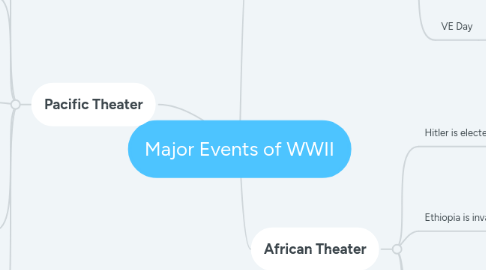
1. Pacific Theater
1.1. Pearl Harbor
1.1.1. Japanese fighter planes attacked US naval base
1.1.2. Devastated the naval base
1.1.3. FDR declared war on Japan
1.1.3.1. US becomes involved in WWII
1.2. Guadalcanal
1.2.1. First major offensive victory for Allied forces
1.2.2. Japanese forces were forced to retreat
1.2.3. Japan loses counteroffensive position on the US
1.3. Battle of Coral Sea
1.3.1. A four day conflict in air-sea battle
1.3.2. Japan seeks to take over coral sea
1.3.3. Japan is defeated by the Allied forces
1.4. Atomic Bomb
1.4.1. Marked the end of WWII
1.4.2. President Trumen wanted to avoid horrific casualties
1.4.3. Dropped on Hiroshima killing 80,000 people
1.4.4. Dropped on Nagasaki killing 40,000 people
1.4.4.1. Forces Japan to surrender
1.5. V-J Day
1.5.1. Japan formally surrenders in a naval base
1.5.2. Japan is forced to deal with the agreement
1.5.3. For 6 years Japan is managed by US
2. African Theater
2.1. Hitler is elected
2.1.1. Was elected Chancellor
2.1.2. Thought to be Germany's hope
2.1.3. Prepares for war
2.2. Ethiopia is invaded
2.2.1. Mussolini ordered to attack Ethiopia
2.2.2. The league powers do not stop Italy's actions
2.2.2.1. Shows League of Nations' weakness
2.3. Nonagression Pact
2.3.1. Soviet Union and Germany forms a pact
2.3.2. Gave greater power to Axis power
2.4. Battle of Stanlingrad
2.4.1. Germany loses the battle
2.4.2. Turning point to the balance of power
2.4.3. Soviets now on the offensive
3. European Theater
3.1. Germany invades Poland
3.1.1. September 1, 1939
3.1.1.1. Germany and Soviets divides Poland
3.2. Lend-Lease Act is signed
3.2.1. Franklin D. Roosevelt signs it in March 11, 1941
3.2.1.1. US lent equipment to any ally
3.3. Battle of El Alamein
3.3.1. Allies wins the battle
3.3.1.1. Lead to Germany's surrender
3.4. D-Day
3.4.1. June 6, 1944
3.4.1.1. Allies launches a surprise attack in Normandy
3.4.2. Germany is finally sure of defeat
3.5. VE Day
3.5.1. Germany formally surrenders to US
3.5.2. Lead to the end of WWII
